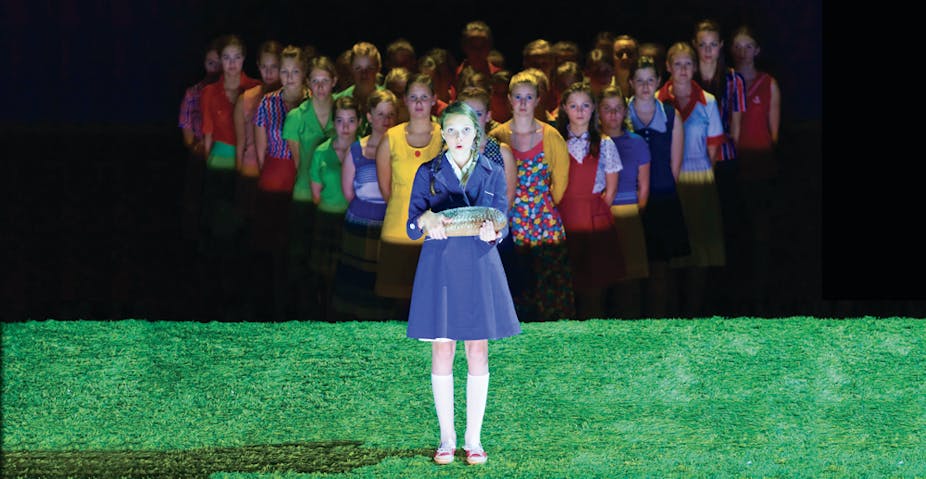When the mountain changed its clothing, the Heiner Goebbels-directed show currently on at the Melbourne Festival, is an evasive piece of theatre, but it is through its elusive and mysterious qualities, underpinned by choral music, that it is able to transcend into something that is beautiful and powerful.
This piece, like most of Goebbels’s works, defies simple categorisation, hovering between theatre, installation and a musical concert.
A literal description of the show would be a series of small vignettes woven together exploring ideas about transition, loss and youth. But in this show the sum of the parts work in gestalt to become an immersive experience that is greater than the whole. Ideas echo throughout the performance, recurring and layering upon each other. Goebbels combines striking theatrical images with musical orchestration that draws from a diverse range of sources, from folk songs to indie pop.
But what really drives this show, its emotional engine as it were, is its young ensemble cast of 40 female teenagers from theatre company Carmina Slovenica and the authentic place it creates to explore the concept of youth and meditate on the idea of becoming. And here the show walks the fine line between the heavy manipulating hand of high avant-garde art and something that is genuine and real.
As an audience, we are conscious of watching untrained performers. This is set up from the very first image of the performance in which we witness a mass of somewhat awkward teenagers meander across the stage, all attired in the t-shirts and runners that you might see in a shopping mall.
The real strength of the show comes from the contrast of the fragility of its young performers and the powerful assuredness of their achingly beautiful choral singing. The vocal harmonies of the ensemble create many different textures from the playful to the deeply visceral, generating moments in which the sound becomes a physical presence that at times seems to penetrate you. It is the power of highly skilled choral music that binds this show, giving it licence to be playful and surreal, allowing it to take intellectual segues.
The show is a series of moments of transition that are cleverly orchestrated in front of our eyes. Lights are hoisted into place, chairs and tables arranged, a pulley tugs a scenic backdrop into place. Goebbels uses these transitions to reveal the unexpected, often becoming magic tricks that transcend what we thought was going on, expanding our perception of the reality of the moment. A ball that we have watched being held tight suddenly floats by itself suspended in the air.
The transition of time is a theme that is constantly explored throughout the show. Goebbels often plays with the idea of slow accumulation, letting moments gradually reveal themselves. We watch while a row of smiling faces seems to be held ridiculously too long only to realise that they are glacially morphing into neutral masks on a descent into sadness and anger.
Another theme explored in the piece is the ever presence of Old Europe. Contemporary teen clothing is swapped for dresses and skirts from an older deeper past, alluding to an era before the breakup of the Soviet Union. Eastern European folk art painting creates a backdrop of a field full of clover and a forest becomes the setting for a rhythmic camp song.
The direction carefully uses the large ensemble, often using small gestures that allow us to see similarities and differences between the large cast such as 40 blonde wigs being flicked in unison, or the nervous energy of swaying legs of a young girl repeated by each member of the cast.
Fragments of conversations about death and the dismantling of the social order are woven throughout the piece.
In one scene we are given a small science lesson in how clouds create electrical charge. These short vignettes give us clues to the meaning and intention of the piece. In another scene two girls hold a relentless conversation about growing old and the inevitability of death. But the performance also appears aware of its own ridiculous hyperbole. A girl in a beret and a blue tunic desperately clutches a loaf of bread while delivering us a deadpan speech about being unafraid of atomic annihilation.
Goebbels has a deft hand at creating moments that surprise, turning the surreal and the macabre into exquisite moments of beauty. This duality was present in one of most moving images of the show in which the gutted entrails of a soft toy become serene clouds floating over a lush green hillside, while the ensemble sings a haunting melody that slowly transforms into the resonating harmonics of throat singing. As one of its final images, this moment seemed to summarise the majestic and disturbing experience of the piece.
While this show will no doubt frustrate some audiences that seek a more traditional protagonist-driven narrative, the best moments of this performance are deeply exhilarating, and carry those rare qualities of indelible theatre that are cherished years after the event.
When the mountain changed its clothing is on at the Melbourne Festival until October 26. Details here.

